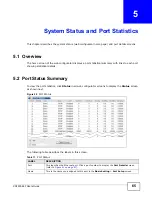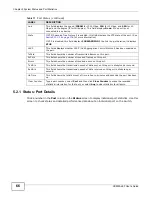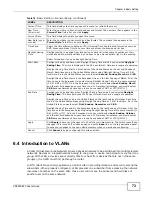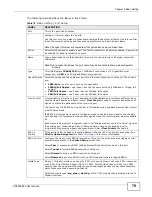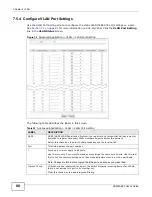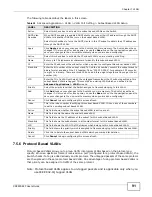
Chapter 6 Basic Setting
XS3900-48F User’s Guide
79
The following table describes the labels in this screen.
Table 18
Basic Setting > Port Setup
LABEL
DESCRIPTION
Port
This is the port index number.
*
Settings in this row apply to all ports.
Use this row only if you want to make some settings the same for all ports. Use this row first
to set the common settings and then make adjustments on a port-by-port basis.
Note: Changes in this row are copied to all the ports as soon as you make them.
Active
Select this check box to enable a port. The factory default for all ports is enabled. A port must
be enabled for data transmission to occur.
Name
Type a descriptive name that identifies this port. You can enter up to 64 alpha-numerical
characters.
Note: Due to space limitations, the port name may be truncated in some web configurator
screens.
Type
This field displays 1000M/10G for a 1000Base-X connection or 10 Gigabit Ethernet
connection, or 40G for a 40 Gigabit Ethernet connection.
Speed/Duplex
Select the speed and the duplex mode of the Ethernet connection on this port. The choices
are:
•
1000-Auto - use if peer is set as auto-negotiable
•
1000M/Full Duplex - use if peer is set as the same settings (1000Base-X, 1Gbps, full
duplex)
•
10G/Full Duplex - use if peer is set at 10Gbps, full duplex.
•
40G/Full Duplex - use if peer is set at 40Gbps, full duplex.
Flow Control
A concentration of traffic on a port decreases port bandwidth and overflows buffer memory
causing frame discards and frame losses. Flow Control is used to regulate transmission of
signals to match the bandwidth of the receiving port.
The Switch uses IEEE 802.3x flow control in full duplex mode and backpressure flow control
in half duplex mode.
IEEE 802.3x flow control is used in full duplex mode to send a pause signal to the sending
port, causing it to temporarily stop sending signals when the receiving port memory buffers
fill.
Back Pressure flow control is typically used in half duplex mode to send a "collision" signal to
the sending port (mimicking a state of frame collision) causing the sending port to
temporarily stop sending signals and resend later. Select Flow Control to enable it.
802.1p
Priority
This priority value is added to incoming frames without a (802.1p) priority queue tag. See
Priority Queue Assignment in
BPDU Control
Configure the way to treat BPDUs received on this port. You must activate bridging control
protocol transparency in the Switch Setup screen first.
Select Peer to process any BPDU (Bridge Protocol Data Units) received on this port.
Select Tunnel to forward BPDUs received on this port.
Select Discard to drop any BPDU received on this port.
Select Network to process a BPDU with no VLAN tag and forward a tagged BPDU.
Media Type
On any 10 Gigabit interface, such as the SFP+ slot, you can insert either an SFP+ transceiver
or an SFP+ Direct Attach Copper (DAC). An SFP+ Direct Attach Copper (DAC) is an SFP+
housing that has no optical module but uses a fixed-length passive copper cable assembly,
which reduces cost and power significantly.
Select the media type (sfp_plus or dac10g) of the SFP+ module that is attached to the 10
Gigabit interface.
Summary of Contents for XS-3900-48F
Page 15: ...15 PART I User s Guide ...
Page 16: ...16 ...
Page 48: ...Chapter 2 Tutorials XS3900 48F User s Guide 48 ...
Page 62: ...Chapter 4 The Web Configurator XS3900 48F User s Guide 62 ...
Page 63: ...63 PART II Technical Reference ...
Page 64: ...64 ...
Page 227: ...Chapter 26 VLAN Mapping XS3900 48F User s Guide 227 ...
Page 320: ...Appendix A Common Services XS3900 48F User s Guide 320 ...
Page 332: ...Index XS3900 48F User s Guide 332 ...

